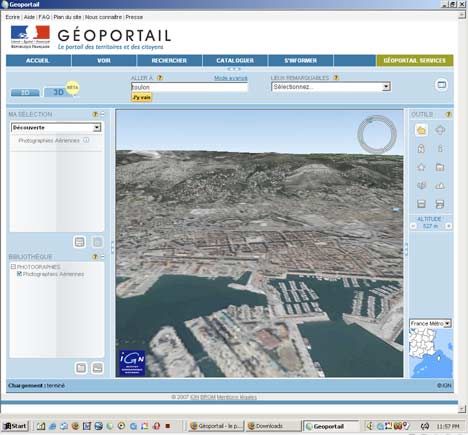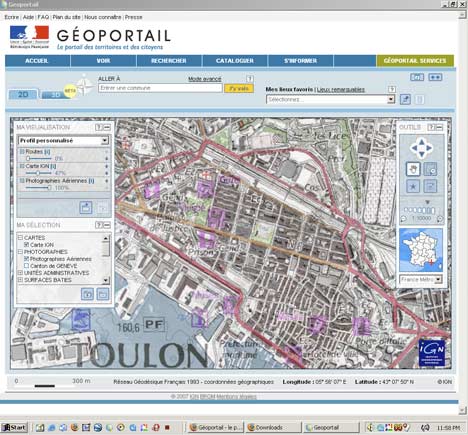 Last summer, amid much fanfare and little server capacity, the France’s National Geographic Institute (IGN) released Géoportail, a 2D web mapping application that was (inaccurately) self-described as France’s answer to Google Earth. A 3D version was promised for 2007. It has now arrived.
Last summer, amid much fanfare and little server capacity, the France’s National Geographic Institute (IGN) released Géoportail, a 2D web mapping application that was (inaccurately) self-described as France’s answer to Google Earth. A 3D version was promised for 2007. It has now arrived.
Géoportail 3D is built upon Skyline Software’s Skyline Globe web browser plugin. Here’s comes my first complaint (what did you expect?): The plugin works on Windows 2000/XP/Vista only, which once again defeats the point of using a web browser to serve the data. (At least there are more Windows options available than the BBC’s XP-only iPlayer for BBC video.) [Update: Mac and Linux will be supported in January 2008, says IGN.] Second complaint: It is slow. On the plus side, the 3D version is clearly marked Beta — which means that these complaints are provisional:-)

Also no sign yet of the 3D buildings with facade mapping that was demoed back in April 2006. Meanwhile, Google Earth just got new high resolution imagery this past weekend for the French Riviera, Arles, Biarritz, Strasbourg, Grenoble, Angers, Amiens, Bourges, Clermont Ferrand, and the Loire River.
But some compliments are in order for the 2D version of Géoportail. Over the past year it has gotten some nifty features, including the ability to adjust the opacity of different mapping layers — for example having the imagery at 100% on the bottom and superimposing the map at 50% on top of it.

Still, the interactive mapping tools that Google MyMaps has made available over the past year makes Géoportail feel so, I don’t know, 2006? What IGN should have done, and what they still could do, is to make their mapping layers available to all comers, be it Google, Microsoft or NASA World Wind, and let them deal with the cut-throat competition of building compelling consumer mapping applications. That’s a completely separate skill from collecting and prepping geospatial data, which is what IGN specializes in, and what it should continue to focus on. IGN is not the French Google, and never will be. (Via Business Garden)
Since the French love their irony, consider the following:
–Microsoft is the favorite whipping boy of EU regulatory authorities who gleefully levy large fines on them as if they were the US Congress treating cigarette companies like ATM machines. Yet Geoportail–the very face of the land of liberte and egalite–only works on Windows, or rather only the most recent versions of Windows.
–Still no WMS services as far as I can tell (you know, one of those open standards that could be easily consumed by multiple desktop and web mapping platforms)
–In the US, we have of course the TerraServer service which makes freely available all of the USGS’ orthophotos, aerial imagery, and topo maps, both through its own map interface as well as WMS services. Oh, and who is the technology partner help making it happen? Microsoft, naturally.
BT
As specified on the Géoportail website, Mac and Linux versions of géoportail 3D are planned for january 2008.
Well, what it seem you may not be aware of, is that the Geoportail was not and is not meant to be the french Google Maps nor Google Earth (even though some journalists got carried over and said that rather often at the start of the portal)…
Its main interest will be (and is starting to be) the access to all geospatial services from official sources in France, be it on their own sites or here on the Geoportail, as well as maintaining some level of similarity between these data (for example by providing the same level of metadata with each layer)
A second point that arose my interest is the whole point on “IGN should make their mapping layer available to everyone”. I guess most at IGN would laugh hearing that. Heck, they even went to the point of having a specific projection system for the Geoportail, coupled to a morph engine so that the data cannot be openly usable by everyone …
See, that’s completely the opposite, don’t you think ?
And, last but not least, for the slowness part. I guess that comes from the fact you connect from the US. From here it’s perfectly smooth and fluid. Even more so than Google Earth (and that is something noteworthy, as GE works perfectly smoothly too)
Best regards,
Pierre.
Hi Pierre. I’m in Sweden, and the slowness concerns the rendering, not the downloading.
You make an interesting about the closing of the data. I think IGN is swimming against the tide of history n this regard. I the future, the more open your data, the more you invite mashups, the more relevant you are. That also goes for a tax-funded agency, where you can make the further point that perhaps it has a moral obligation to make the results of its work available to all citoyens.
Hi Stefan.
As for the rendering speed, i cannot really help you but only point at the fact the Geoportail is using both more precise pictures (as can be seen with a max zoom in) which means larger textures and more precise DEM meaning more polygons on screen at the same time. That may explain the rendering speed you experience. But here are just suppositions, not “truth”.
As for the closing of the data, you might find interesting to keep in mind that IGN must sell its data to keep its work going. No sales, no income or at least not enough to carry on with the frequent updates (and the french state will NOT give more fund to the agency, that’s not an option … so they’ve got no choice but being commercial)
I agree with the interest of a tax-only fund agency. But it’s not the way it’s going. They have fixed public fund income and precise objectives. To reach those, they have no choice but not giving away their data freely.
So it’s not IGN going against the tide of history. It’s them doing what they can to keep a good product quality, and even improve it (not that they have the choice by the way).
Best regards,
Pierre.
@ Pierre:
Many of the issues you brought up about funding, the agency having to generate its own revenue, etc., are being wrestled with by most government entities that have the mandate to collect, verify, and distribute spatial data.
The collection and verification (qa/qc, metadata, etc.) aspects are critically important–no one is disputing that. However the distribution of spatial data is a whole different beast: five years ago, if one wanted to publish information on the web, the investment in infrastructure was considerable–web servers, map servers, database administration, etc. With the emergence of the Google/Yahoo/Microsoft platforms with their open APIs, the ability to integrate their infrastructure with your data at a low cost is (or should be) extremely attractive.
Now the concerns of public entities mixing their data with the platforms of for-profit companies who could change or remove their services at a whim are valid. But here’s where the importance of open standards comes into play: WMS, WFS, soon-to-be-a-standard KML both 1) give an organization the ability to publish to a wide variety of platforms and audiences and 2) act as insurance policies against vendor lock-in.
In a perfect world public agencies would focus their efforts and budget on capturing and maintaining high quality datasets and make those available as services (with open source software) and let end-users decide how to consume the information.
Sure the “cost-recovery” question persists, but I think only in a narrow sense. To me, the GIS community has been too shy about the importance of what they do and now we have the Googles and Microsofts spending 100s of millions of dollars because they see spatial information and visualization as linch-pins of future profit-making. So with the dramatically elevated profile of all things geo, it’s time to stand up and say that spatial data is critical infrastructure and shouldn’t be forced to justify itself in a penny-for-penny cost-recovery way any more than other basic services government entities provide.
Thanks,
Brian
The French should open their data, huh? You mean, it’s not a good practice to give yourself exclusive rights to data?
Maybe Google should not have exclusive rights to DigitalGlobe data then? Glass houses…
Neither Google nor DigitalGlobe are a government entity funded by taxpayers.
My mistake – I thought you meant “Data should always be publicly available so the best technology can be chosen regardless of the data that is being rendered” as opposed to “Data should be publicly available when there isn’t a commercial interest from a company that has the wherewithal to purchase exclusivity.”
I don’t like exclusive agreements as I find them extremely anti-competitive and generally come from bigger companies who would like to expend resources to guarantee their market share rather than competing on the technology level (I’m not saying Google Earth is a bad product). Look no further than EA Sports exclusive agreement with the NFLPA for another example of this.
IGN is providing a service that utilizes their data, not the data itself. If that’s their prerogative, I don’t see anything wrong with that.
Geoportail was never meant to replace Google in any way. It is just a site for French citizens who are interested in the info it makes available.
One question for the anti-French around the world, and in particular on this website: if France and the French are so stupid, obsolete and irrelevant, why do you so painstakingly spend your time scrutinizing what they do ???
It’s like the French social system. Americans, while croaking in their shitty medical system manage to continue predicting the fall of the French system. This has been going on for decades. Yet, Cassandrists have still to be proven right. As a famous American once said ” those who say it can’t be done shouldn’t bother those who are doing it “.
Wuck, just because you think people here are anti-French doesn’t make it so. I’m an equal-opportunity critic of bad decisions — note the mention of the BBC in the article.